We have a publishing day treat for readers with an excerpt from Emily Carpenter’s brand new thriller Gothictown, out today from Kensington Books!
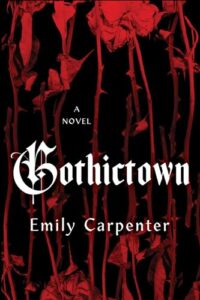 Manhattan chef Billie Hope is feeling at a loose end: her restaurant has closed and she’s feeling more than a little lonely, despite enjoying the (unfortunately) abundant free time she now has to spend with her husband Peter and daughter Meredith. So when she gets an email from the small Georgia town of Juliana, incentivizing new residents to move in with promises of affordable living, ample job opportunities and a welcoming community for all, it’s a siren song that neither she nor her family can resist.
Manhattan chef Billie Hope is feeling at a loose end: her restaurant has closed and she’s feeling more than a little lonely, despite enjoying the (unfortunately) abundant free time she now has to spend with her husband Peter and daughter Meredith. So when she gets an email from the small Georgia town of Juliana, incentivizing new residents to move in with promises of affordable living, ample job opportunities and a welcoming community for all, it’s a siren song that neither she nor her family can resist.
At first, Juliana seems as amazing as advertised. But soon after settling in, Billie begins to sense that something deeply unsettling is lurking beneath the town’s genteel surface. The three founding families known as The Old Guard seem a little too invested in the town’s well-being, to the point that they’ll sweep anything that could mar Juliana’s perfect image — unpaid taxes, disappearances, even death — under the rug.
As the Hope family begins to experience unusual new physical and emotional symptoms, Billie makes a horrifying discovery that will set her on a collision course with the truth about Juliana’s secret past — and with the Old Guard who will do whatever it takes to not only keep their secrets buried, but also keep Billie a part of their idea of Juliana forever.
Read on for a seductively written excerpt that almost had me ready to pack up my family and head down to Georgia myself!
Continue reading
Permanent link to this article: https://www.thefrumiousconsortium.net/2025/03/25/gothictown-by-emily-carpenter-excerpt/
This second Monti & Leo book finds the two best friends embroiled in a series of conundrums, one light-hearted but one decidedly serious, as collecting mania comes to Pocketville!
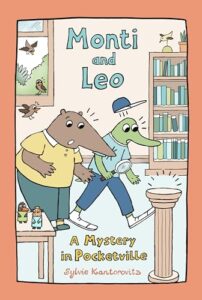 Mrs Sheep has generously allowed her collection of figurines to be displayed at the local library. As the Pocketvillians ooh and aah over the scope of her collection, many express an interest in starting up collections of their own. Not of dolls, necessarily, as everyone has their own interests. Leo, for one, already has a collection of neat rocks that he’s proud to show off to Monti.
Mrs Sheep has generously allowed her collection of figurines to be displayed at the local library. As the Pocketvillians ooh and aah over the scope of her collection, many express an interest in starting up collections of their own. Not of dolls, necessarily, as everyone has their own interests. Leo, for one, already has a collection of neat rocks that he’s proud to show off to Monti.
Everyone is enthusiastically discussing what they intend to collect and sharing their finds with their friends… all except Monti, who can’t seem to decide what interests him the most. But bigger worries are on the horizon for him, when the prize figurine in Mrs Sheep’s collection goes missing. Monti, who’d loudly admired the doll, becomes prime suspect in its disappearance.
Leo is aghast, not only at the aspersions cast on his poor friend but at the doubts that come crowding into his head as a result of Mrs Sheep’s accusations. Determined to quiet all the voices, he sets out to investigate who might have stolen the figurine and why. The path to the truth isn’t straightforward, especially when the figurine seems to be only the first in a series of items missing from the collections of Pocketvillians. Will Leo be able to get to the bottom of things? Will Monti finally be able to figure out what he wants to collect?
Continue reading
Permanent link to this article: https://www.thefrumiousconsortium.net/2025/03/24/monti-and-leo-a-mystery-in-pocketville-by-sylvie-kantorovitz/
In some distant and ultimately irrelevant future, humanity has mastered time travel and discovered not a single causal chain through the unity of time and space, but a vast multitude of timelines. They cluster in groups of similar development. In some, humanity spreads to the stars; in others, humanity remains more tightly tied to its origins. Perhaps inevitably, strife follows humans not only to the stars but throughout all of accessible time. The book does not say how the two factions — Garden and Agency — came to be, nor which, if either of the two, discovered time travel.

As the book opens, the two sides are at war and have been for an immeasurable span of time. They have incompatible visions of the future, and of the past and present for that matter. They represent different modes of living, of development. Garden is all about growing and cultivating, though of course they keep the technology required for travel through time and space. The Agency is a more mechanized future, where devices serve humanity and support civilization. If sometimes the line between people and machines blur, well, it has been that way at least since the first glass sphere purported to replace an eye. And the people that Garden grows in pods, well, humanity was tied to cultivation before history began.
But This Is How You Lose the Time War is about neither the technology and paradoxes of time travel, nor the two visions and factions that define time-traveling humanity. It is a love story.
Continue reading
Permanent link to this article: https://www.thefrumiousconsortium.net/2025/03/23/this-is-how-you-lose-the-time-war-by-amal-el-mohtar-and-max-gladstone/
Hello, dear readers! With the advent of the spring equinox, I’m going to pivot towards spotlighting upcoming books in this column and not just ones that have recently published that I’m super excited to get to. So here’s a bonus column rounding up some of those latter, beginning with the third and latest installment of the bestselling The Kindred’s Curse Sage, Penn Cole’s Heat Of The Everflame.
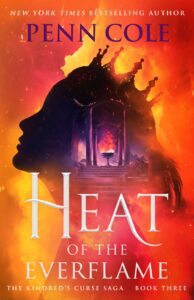 After her disastrous coronation, Diem finds herself at the center of the conflict between the Descended and the Guardians. With her newfound friends and the man she’s falling for on one side, and the mortals she has vowed to protect on the other, Diem must walk a careful line to save the people she loves… even that means saving them from each other.
After her disastrous coronation, Diem finds herself at the center of the conflict between the Descended and the Guardians. With her newfound friends and the man she’s falling for on one side, and the mortals she has vowed to protect on the other, Diem must walk a careful line to save the people she loves… even that means saving them from each other.
When the mystery of her unusual heritage begins to unravel, it sends Diem and Luther on an unexpected journey across the realms. The answers they seek may hold the key to winning the war, but finding these answers will require Diem to face painful truths about her mother, her bloodline and her very fate.
Meanwhile, the Crowns have set Diem in their sights. Some of them could be her greatest allies, while others want her dead. In order to end their oppressive reign, Diem must sort friend from foe and risk it all to build an army of her own. But a powerful figure in the north has plans that could change everything…
The collectible hardcover edition also includes gorgeous full-color endpapers, an exclusive hardcover case and a never-before-seen bonus chapter written from Luther’s point of view. Get it while it’s still in stores!
Continue reading
Permanent link to this article: https://www.thefrumiousconsortium.net/2025/03/21/tantalizing-tales-march-2025-part-two/
Young Bertie Wells has always had the imagination of an inventor. But when he accidentally creates a black hole in his bedroom, he’s not prepared for either that or for the sudden appearance of a strange woman bearing an invitation for him to attend the Everwhen School of Time Travel and Other Odd Sciences. Not only is this a school set outside of the time-space continuum for bright students such as himself, it’s also offering him a highly coveted Time Scholarship, by way of the kind, if eccentric, Professor Darla Marconi.
 Bertie doesn’t want to tell Professor Marconi that the black hole was created less on purpose than by accident. The last thing he needs is further ammunition for his disapproving father’s continuing belief that Bertie is never going to amount to anything. This, perhaps, might be his best chance of escaping the drudgery of finding a trade to apprentice in, so off he goes to Everwhen, little realizing that he’s embarking on the adventure of several lifetimes.
Bertie doesn’t want to tell Professor Marconi that the black hole was created less on purpose than by accident. The last thing he needs is further ammunition for his disapproving father’s continuing belief that Bertie is never going to amount to anything. This, perhaps, might be his best chance of escaping the drudgery of finding a trade to apprentice in, so off he goes to Everwhen, little realizing that he’s embarking on the adventure of several lifetimes.
Everwhen is weird and wonderful, filled with fantastic scientific marvels from all eras of time. Bertie quickly makes friends with Millie da Vinci, the much put-upon younger sister of the celebrated Leonardo, and Zoe Fuentes, a brainiac recruit from 2025 who’s accompanied everywhere by her trio of colorful slimes. The three new friends are assigned, as all first-year Time Scholars are, to Haz-Labs, the clean-up crew of the entire school. Haz-Labs is not only considered their extracurricular for the whole of first year but also makes up their team for the Ever-Ring Competition, a school-wide contest that rewards the best half-year student invention. This is a big deal because the winning student’s lab gets the best school perks, including choice of classes, housing and extra free periods.
Continue reading
Permanent link to this article: https://www.thefrumiousconsortium.net/2025/03/20/the-doomsday-vault-everwhen-school-of-time-travel-1-by-thomas-wheeler/
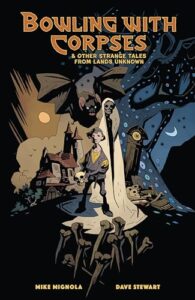 subtitled & Other Strange Tales From Lands Unknown. With lettering by Clem Robins.
subtitled & Other Strange Tales From Lands Unknown. With lettering by Clem Robins.
Y’know, I never seemed to hit Mike Mignola’s work at quite the right time. I’ve long been interested in the Hellboy and BPRD franchises, but every time I managed to pick up a book, I was quickly flummoxed by being required to know far more back story than I had grasp of in order to enjoy the current one I was trying to read.
So it’s honestly really great that I could hit the ground running here in Mr Mignola’s new project, where he builds an entirely new mythology in a world similar to our own yet very different. The title story is actually based on an Italian folktale, but Mr Mignola invents a brand new realm, new challenges, new rewards and a bittersweet ending. Folk tale aficionados will see the twist coming from a mile away but who cares when Yeb has arguably the coolest melee weapon of all time?
The rest of this collection’s stories follows less of an overarching narrative — I don’t believe we see Yeb again in the rest of the book — than it sweeps broadly through this fantastic new landscape, picking out fresh and seemingly random tales for the reader’s delectation. These tales lean towards the horrific side of fantasy: no surprise given the author. But Mr Mignola’s mastery of suspense has only grown since the other books I’ve read of his, particularly in the tale Una And The Devil, where a blacksmith’s daughter facing the gallows in the morning finds a different kind of salvation… and vengeance. That tale especially shows a flair for creativity quite different from the more standard folk tales on which most of this book is based.
Continue reading
Permanent link to this article: https://www.thefrumiousconsortium.net/2025/03/19/bowling-with-corpses-by-mike-mignola-dave-stewart/
In my quest to read all of Diana Wynne Jones’s books in one year, this month I read The Crown of Dalemark, Stopping for a Spell, and The Tough Guide to Fantasyland!
Seriously, this was quite a lineup for a short month: it included our first ending of a series, our first collection of shorter works, and an alphabetized guidebook to fantasy tropes! All of these were rereads for me, and I felt like I gained perspective on all of them through the context of this readthrough process.
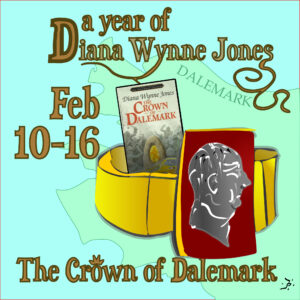 The Crown of Dalemark, (1993)
The Crown of Dalemark, (1993)
In the late 1970s, Diana Wynne Jones published three Dalemark novels: first, two novels of Dalemark in a kind of early industrial revolution era, with Cart and Cwidder and Drowned Ammet in 1975 and 1977, taking place concurrently, in a land with slow travel, magic stuff, and firearms being introduced. Then came Spellcoats in 1979, which brought us back to an origin point of the very founding of Dalemark, far in the distant and mythologized past.
Over a decade later, the series concludes with The Crown of Dalemark: we meet Maewen, a girl in an era of Dalemark that feels contemporary to the 1990s: fast trains, divorced parents, boarding school shenanigans – the whole works. She gets tricked into traveling back in time to the era of Cart and Cwidder and Drowned Ammet, in order to aid the gods of Dalemark in restoring a rightful king to the empty throne.
Continue reading
Permanent link to this article: https://www.thefrumiousconsortium.net/2025/03/18/a-year-of-diana-wynne-jones-the-mid-1990s/
The global COVID-19 lockdowns were a tough time for millions around the globe, in no small part due to the confrontation many people had with whether or not they actually enjoyed living with themselves. One such person is Mylo Gunn, a fifty year-old Black American whose extra time for introspection butts up against the burgeoning #MeToo movement, exposing parts of himself he’d thought long buried.
 Back when Mylo was seventeen, he met and fell and love with the beautiful twenty-five year-old April Barnes. While many of the people around him told him to be careful with her, nobody really tried to stop him from pursuing a relationship with a woman who was definitely not respecting the “half your age plus seven” years rule of dating suitability. Over time, April groomed Mylo into being the boyfriend, and later husband, she desired. Tho Mylo knew that the way she treated him was wrong, he didn’t know how to permanently extricate himself from a woman he thought he loved and, eventually, owed.
Back when Mylo was seventeen, he met and fell and love with the beautiful twenty-five year-old April Barnes. While many of the people around him told him to be careful with her, nobody really tried to stop him from pursuing a relationship with a woman who was definitely not respecting the “half your age plus seven” years rule of dating suitability. Over time, April groomed Mylo into being the boyfriend, and later husband, she desired. Tho Mylo knew that the way she treated him was wrong, he didn’t know how to permanently extricate himself from a woman he thought he loved and, eventually, owed.
Fast-forward several decades, and Mylo is happily married to his second wife, Traci, as they ride out the lockdowns together. Looking for an athletic release when restrictions eventually ease, Mylo takes to open-air training with a group of guys he meets at a nearby track. When one of them encourages him to explore the feelings he’s started having regarding his first wife and their tumultuous relationship, he makes the first tentative steps to putting his story down on paper, little realizing the hidden connection that will later rock his world.
Continue reading
Permanent link to this article: https://www.thefrumiousconsortium.net/2025/03/17/groomed-by-jody-paschal/
A City on Mars asks in its subtitle “Can We Settle Space, Should We Settle Space, and Have We Really Thought This Through?” When I read part of the book to decide how to vote on its place in the 2024 Hugo Awards category of Best Related Work I thought that the answers were “probably not, probably not, and definitely not” but allowed for the possibility that after reading the whole thing they might be even simpler: no, no, and no. Now that I have taken time to read the full argument, I think the answers are “maybe but not for a long time, only under certain circumstances and again not for a long time, and oh hell no.” That’s not really the story the Weinersmiths wanted to tell when they started their project, but it’s the conclusion they came to after a long and fair look at many aspects of space settlement.

The text is breezy and conversational, punctuated by well-chosen illustrations by Zach, but the subject and conclusions are plenty serious. The American government, along with two of the world’s richest men, are investing significant resources into promoting and achieving some form of space settlement in the nearish future. Elon Musk’s promises, and especially his timetables, on that front have turned out to be vaporware, but his company continues to push in that direction. His attitude toward law, as revealed in his actions in early 2025, shows the importance of a topic that the Weinersmiths devote considerable attention: the laws and agreements that regulate human activities in space, how those came to be, how they work in both theory and practice, and how they will shape attempts at settling celestial bodies beyond the Earth. Those are topics that tend to get short shrift in much writing about space settlement. That’s unfortunate because attempting to place a new settlement on the Moon or on Mars would be an immense social effort, and those don’t happen outside of legal and political frameworks. The Weinersmiths tackle legal and social questions last because those are the most difficult; although they don’t directly say that God gave physicists the easy problems, it’s true.
Continue reading
Permanent link to this article: https://www.thefrumiousconsortium.net/2025/03/16/a-city-on-mars-by-kelly-and-zach-weinersmith/
I continue to be flummoxed by the concept of time, dear readers, as March comes in like a lion here in my mid-Atlantic state. It has also been, quite frankly, a tough time to be a professional reader. It feels like one catastrophe after another threatening everything I hold dear, through the diabolical intersection of short-sighted technoligarchy with ethno-nationalist fascism. Frankly, I’m exhausted (and don’t get me started on how the Daylight Savings time change during the fasting month has thoroughly messed with my circadian rhythms.)
 But at least I have books to help me through, even if they’re books that I can only look forward to reading once I finally find the time again. The first of these, timed perfectly to Women’s History Month, is Marianna Marlowe’s Portrait Of A Feminist: A Memoir In Essays. Through flashes of memory of her childhood in California, Ecuador and Peru, interspersed with scenes from the present day, Ms Marlowe details the evolution of her identity as a biracial and multicultural woman.
But at least I have books to help me through, even if they’re books that I can only look forward to reading once I finally find the time again. The first of these, timed perfectly to Women’s History Month, is Marianna Marlowe’s Portrait Of A Feminist: A Memoir In Essays. Through flashes of memory of her childhood in California, Ecuador and Peru, interspersed with scenes from the present day, Ms Marlowe details the evolution of her identity as a biracial and multicultural woman.
With her experiences being the child of a Catholic Peruvian mother and an atheist American father in a family that lived abroad for years, she confronts the realities that so many of us share, including unequal marriages, class structures, misogynistic literature and patriarchal religion. Her essays bring her to the two most important questions in feminism today: What does it look like to live a life in defense of feminism? And how should feminism continue to evolve in the present day?
I’ve heard mixed reviews of this one, which only piques my interest all the more. So many people have different ideas of what feminism means that it’s always intriguing to see how someone boldly proclaims the title of feminist for themself, especially in the context of intersectionality. I’m looking forward to getting a chance to dive in.
Continue reading
Permanent link to this article: https://www.thefrumiousconsortium.net/2025/03/14/tantalizing-tales-march-2025-part-one/
 Manhattan chef Billie Hope is feeling at a loose end: her restaurant has closed and she’s feeling more than a little lonely, despite enjoying the (unfortunately) abundant free time she now has to spend with her husband Peter and daughter Meredith. So when she gets an email from the small Georgia town of Juliana, incentivizing new residents to move in with promises of affordable living, ample job opportunities and a welcoming community for all, it’s a siren song that neither she nor her family can resist.
Manhattan chef Billie Hope is feeling at a loose end: her restaurant has closed and she’s feeling more than a little lonely, despite enjoying the (unfortunately) abundant free time she now has to spend with her husband Peter and daughter Meredith. So when she gets an email from the small Georgia town of Juliana, incentivizing new residents to move in with promises of affordable living, ample job opportunities and a welcoming community for all, it’s a siren song that neither she nor her family can resist.








